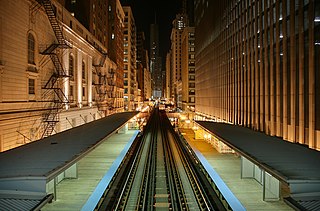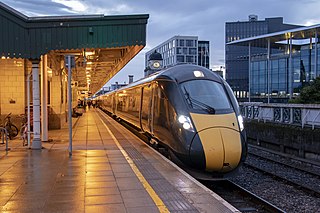
A tram is a type of urban rail transit consisting of a rail vehicle, either individual railcars or self-propelled trains coupled by a multiple unit, that runs on tramway tracks on urban public streets; some include segments on segregated right-of-way. The tramlines or networks operated as public transport are called tramways or simply trams/streetcars. Many recently built tramways use the contemporary term light rail.

Transport in the United Kingdom is highly facilitated by road, rail, air and water networks. Transport is a devolved matter with each of the countries of the United Kingdom having separate systems under separate governments.

Light rail transit (LRT) is a form of passenger urban rail transit characterized by a combination of tram and rapid transit features. While its rolling stock is similar to that of a traditional tram, it operates at a higher capacity and speed and often on an exclusive right-of-way. In many cities, light rail transit systems more closely resemble, and are therefore indistinguishable from, traditional underground or at-grade subways and heavy-rail metros.

The South Yorkshire Supertram, sometimes referred to as the Sheffield Supertram, is a tram and tram-train network covering Sheffield and Rotherham in South Yorkshire, England. The network is owned and operated by the South Yorkshire Mayoral Combined Authority (SYMCA).

A tram-train is a type of light rail vehicle that both meets the standards of a light rail system, and also national mainline standards. Tramcars are adapted to be capable of running on streets like an urban tramway but also be permitted operation alongside mainline trains. This allows services that can utilise both existing urban light rail systems and mainline railway networks and stations. It combines the urban accessibility of a tram or light rail with a mainline train's greater speed in the suburbs.

The Blackpool Tramway runs from Blackpool to Fleetwood on The Fylde in Lancashire, England. The line dates back to 1885 and is one of the oldest electric tramways in the world. It is operated by Blackpool Transport Services (BTS) and runs for 18 km. It carried 4.9 million passengers in 2022/23.

Urban rail transit is a wide term for various types of local rail systems providing passenger service within and around urban or suburban areas. The set of urban rail systems can be roughly subdivided into the following categories, which sometimes overlap because some systems or lines have aspects of multiple types.

The Leeds Supertram was a proposed light rail/tram system in Leeds and West Yorkshire in England. It would have been a three-line, 17-mile (27 km) system with 50 stations. It received provisional government approval in 2001, and was specifically for corridors ill-served by the existing heavy rail network. Supertram would have been 75% funded from the public sector, with final contracts for construction and a 27-year operating concession due to have been awarded in 2003. By 2004, disquiet about rising costs had caused the scheme to be scaled back, and it was finally cancelled in 2005 by the Transport Secretary, Alistair Darling.

The Karlsruhe model is a tram-train system which consists of tram/light rail trains and commuter/regional rail trains running on the same set of tracks, generally between or outside of urban areas. It was initially developed and implemented in the city of Karlsruhe, Germany, by the local transit authority, Karlsruher Verkehrsverbund (KVV).

Transport in Wales is heavily influenced by the country's geography. Wales is predominantly hilly or mountainous, and the main settlements lie on the coasts of north and south Wales, while mid Wales and west Wales are lightly populated. The main transport corridors are east–west routes, many continuing eastwards into England.
Rapid transit in the United Kingdom consists of four systems: the London Underground and the Docklands Light Railway in London; the Tyne and Wear Metro in Tyne and Wear; and the Glasgow Subway. The term may also include commuter rail systems with aspects of rapid transit such as the London Overground and Elizabeth line in London, and Merseyrail in the Liverpool City Region. Rapid transit has also been proposed in other UK cities including Sheffield, Manchester, Leeds, Birmingham, Cardiff, Bristol, and Cambridge.

Urban andsuburban rail plays a key role in public transport in many of the major cities of the United Kingdom. Urban rail refers to the train service between city centres and suburbs or nearby towns that acts as a main mode of transport for travellers on a daily basis. They consist of several railway lines connecting city centre stations of major cities to suburbs and surrounding towns.

Bristol Supertram was a proposed light rail system for the Bristol and South Gloucestershire regions of England. In 2001, the project was given backing from the government to build a line that would link the city centre with the North Bristol region, but the project was cancelled in 2004.

Trams in England encompass various tram networks integrated into the public transport system of England. Until 1935, there had been a large and comprehensive network of tram systems in towns and cities.

The British Rail Class 399 Citylink is a type of rail vehicle built by Vossloh on its Citylink platform for operation by Sheffield Supertram. Primarily a low-floor tram, it is also capable of being used on the National Rail network; the Class 399 is the first such tram-train to see operational use in the United Kingdom.

The Stadler Citylink is a series of tram-trains manufactured by Stadler Rail at its Valencia factory since 2011. The design was introduced by Vossloh España before their takeover by Stadler Rail in 2015. They are currently used in Germany, Hungary, Mexico, Spain and the United Kingdom, with more on order in Austria.
The city of Bristol in the United Kingdom has included a light rail transport system in its plans from the 1980s onwards. There has been no light rail in the city since the closure of Bristol Tramways in 1941.















